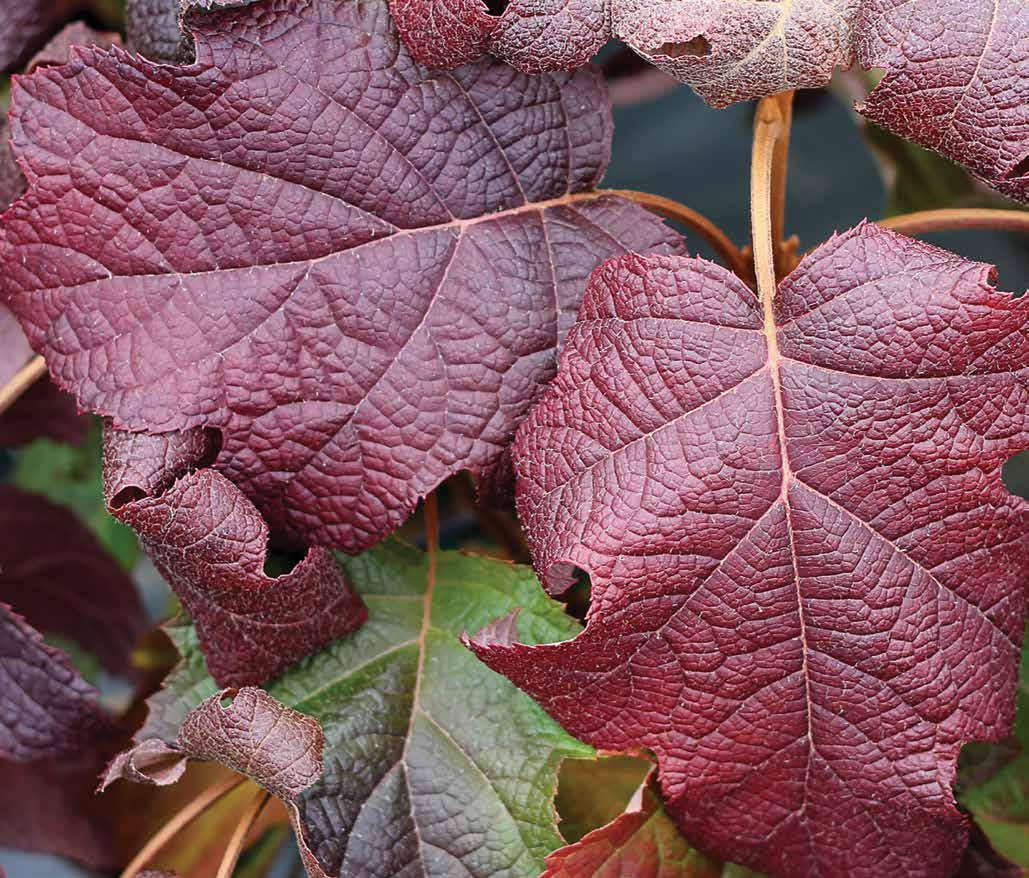

GARDENER
Independently owned and operated since 1996
PUBLISHER
Michael Cavanaugh
EDITOR
Elizabeth Cavanaugh
CONTRIBUTORS
Amy Albright
Matt Bunch
Emma Davison
Laura Dickinson
Jeni Efird
Stephen Fenske
Tracy Graybill
Markis Hill
Lenora Larson
Tamra Reall
Anthony Reardon
Ginny Varraveto
Anne Wildeboor
Scott Woodbury
DISTRIBUTION
Publishers Delivery Solutions, Inc.
IF YOU WOULD LIKE TO DISTRIBUTE the magazine at your place of business, please contact Mike Cavanaugh at mike@kcgmag.com 913-648-4728
NEED MORE MAGAZINES? mike@kcgmag.com 913-648-4728
CONTACT US P.O. Box 8725 Prairie Village, KS 66208 913-648-4728
ADVERTISING
Mike Cavanaugh at mike@kcgmag.com 913-648-4728
QUESTIONS ABOUT
AND
Elizabeth Cavanaugh elizabeth@kcgmag.com 913-648-4728
HOW TO SUBSCRIBE See details on page 23.
WEBSITE kcgmag.com


TAh, September
he autumnal equinox falls on September 22, a consequential time of year. The beginning of cooler temperatures, increased chances of precipitation, and soon the landscape will be awash in brilliant fall color.
Gone are the days of oppressive heat where close attention was paid to newly planted trees and shrubs, ensuring supplemental water when rainfall was inadequate.
On other fronts, parents usher excited children into classrooms signifying the beginning of a new school year. Eager college freshman explore living and learning away from home. It is harvest time for apples, garlic, and the last of the tomatoes.
Now it’s time to refresh containers of weary summer annuals with classic fall favorites like mums.
Speaking of containers, we recently received a photo of our 4-year-old granddaughter. There she was on a Saturday morning, still in her nightgown and crocs, with a watering can tending the little plants on the porch. (The ‘cute meter’ was off the charts.) Her dad suggested this was a glimpse into the future. Think-
ing of that made me laugh out loud. I was transported back to the days when our children were youngsters playing in the dirt and wielding a garden hose. There were plenty of wheelbarrow rides into crazyville, jumping into leaf piles, and doing kind things like planting up pots for the neighbors. Lots of popcicles were awarded to them and their friends for simply showing up. Those are magical memories, and it soothes my soul to witness another generation of gardeners in the making.
Another notable beginning is the start of this magazine. Thirty years ago this month we published the very first issue of The Kansas City Gardener. Merely six months after moving to the Midwest we launched this idea of a monthly gardening magazine. This concept was generously supported by local businesses in the green industry looking for affordable advertising options. The late Dennis Patton, Johnson County extension agent, was our biggest supporter of content, by sharing research-based information so to educate readers. Information continued
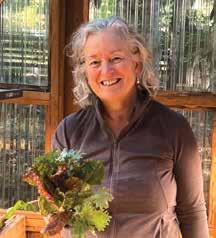
to flow in from more area experts. Like talking across the garden gate, readers also have been supplied with knowledge from local gardeners willing to share what works in their garden.
We have been embraced by the welcoming arms of the Midwest gardening community, advertisers and readers alike. Please know how deeply grateful we are.
Now, on to another season in the garden.
I’ll see you in the garden!

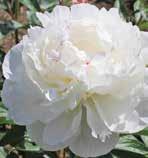
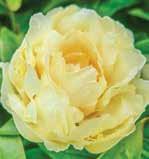

HUGE PEONY SALE
Saturday, November 8th
9:30 a.m. to 3 p.m. (or until sold out) LOCATION: 75th & Nall Ave. Asbury United Methodist Church 5400 W. 75th St., LOWER LEVEL, Prairie Village, KS 66208
a variety value pack of three different peonies and an extensive selection of choice, hard-to-find colors, and a wonderful selection of Herbaceous and Intersectional peonies.

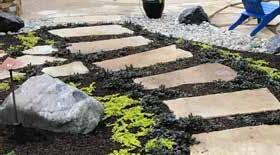






lbpavlak@gmail.com

(CLOSED Mon. 9/1 Labor Day) Come enjoy Autumn at Arnold’s Prairie Sept. Special: Free 4-pack of Fall Annuals w/ $39 purchase! Delicious Idaho Peaches arrive mid-September Call to pre-order peaches & save! Call, email or see our Facebook page for info. on Fall Classes & Workshops
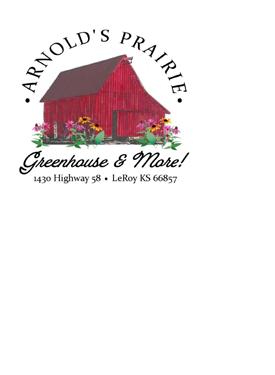
Sun 1 - 5 pm

Ask the Experts
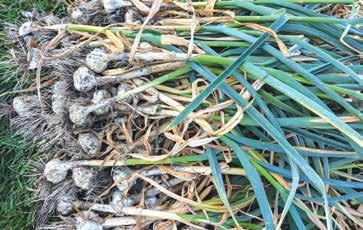
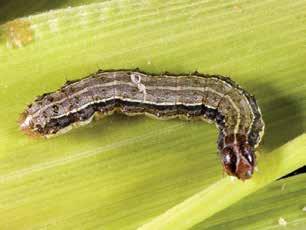
Question: It seems like I just harvested my garlic and I am already preparing for planting the next round! Any tips for doing this?
Anthony’s Answer: Yes, with garlic harvest in July and planting in October, it can seem like the crop just finished leaving your garden when it’s time to start growing it again. Nevertheless, in the two and a half months of downtime between these events, gardeners can take care to tackle a few different tasks in the garden, preparing for their next round of aromatic morsels.
Gardeners should remember that garlic prefers loose and well-draining soil, rich in organic matter. Because of this, right now is the time to amend beds with plentiful compost and a balanced fertilizer.
When sourcing the garlic cloves that will be utilized, a reputable seed company or a local farmer’s market may be your best bet in finding nondiseased parent cloves to work with. Like ornamental spring bulbs, garlic bulbs need to be planted in the fall

so they can undergo a cold treatment known as vernalization, triggering internal shifts to happen within the plant during the coming growing season.
Add mulch prep to your fall to-do list. Garlic especially benefits from straw or shredded leaves, which help suppress weeds and insulate the soil for healthier growth.
A BATTALION OF CATERPILLARS IN MY LAWN
Question: Large brown patches suddenly appeared in my lawn. I looked closer and found a lot of little caterpillars crawling around. What are they, and why are there so many?
Markis’ Answer: You’ve likely got fall armyworms—non-native caterpillars that are a major turfgrass pest in Kansas. Their moths migrate north in the growing season, and a single female can lay up to 1,000 eggs. As the caterpillars grow, they move in groups (“armies”) and chew through grass quickly, sometimes overnight.
Natural predators like birds and
wasps may help a bit, but won’t fully control them. A good tactic is to scout your lawn regularly by pouring soapy water on patches and watching for caterpillars to surface. Hand-pick and dispose of them if possible. If you choose to use an insecticide, apply early—once caterpillars are large, they cause more damage and are harder to kill. Or, if you’re feeling bold, they’re not immune to a solid squish.
BUILD COLD FRAME FROM REPURPOSED MATERIALS
Question: I really want to give a cold frame a try this winter, but I don’t want to spend a lot of money on it. Any tips for a cheap one?
Anthony’s Answer: Upcycled garage items can be your best friend when creating garden structures like cold frames. While old windows make great lids, other materials like clear plastic, old furniture, insulated boxes, and PVC frames can also be utilized. So long as they can still capture heat, let in light, retain moisture, and protect from the cold, the frames should be functional.
Pro tip: Ensure the plants inside never come into contact with the top or edges of the frame, as this is where frost damage could still occur.
CONCERN FOR DEFORMED LEAVES
Question: The leaves on my tree, shrub, or flowers have looked deformed all season. Some have brown spots, curled yellow margins, and smaller growth than normal. What’s wrong with my tree? Will it recover?
Markis’ Answer: This sounds like herbicide damage. Even if your plant wasn’t sprayed directly, tiny droplets or vapors may have drifted from a nearby lawn treatment and landed on sensitive, young leaves. Lawn herbicides are often applied in a short window during spring or early summer for best weed control. When temperatures rise, some herbicides can turn into a gas and travel through the air—a process called volatilization. To get ahead of the heat, people may apply these products too quickly, sometimes on windy days, increasing the risk of drift onto non-target plants.
The good news: if your tree is still alive and growing, it may recover next season. To help prevent this in the future, remind applicators to read the label, follow directions, apply during proper weather conditions, and use PPE to protect both people and plants.
If you’re unsure whether herbicide damage is the culprit, consider consulting your local Extension office at garden.help@jocogov.org or a certified arborist. They can help confirm the issue and offer guidance on how to support plant recovery.
ANTHONY REARDON | Horticulture Agents | MARKIS HILL
Anthony and Markis are the horticulture agents for Johnson County K-State Research and Extension, each specializing in edible crops and ornamentals, respectively. For free information fact sheets, visit www.johnson. ksu.edu, or call the Extension office at 913-715-7000.












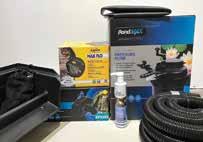



Adult butterflies seem so fragile and defenseless, but they have survived over 100 million years since evolving from moths. This evolution included numerous “upgrades” from moths’ appearance and behavior that improved the butterflies’ odds of survival. But first, why switch from being drab night-flying moths to colorful daytime aviators? Scientists had theorized that butterflies evolved from moths to avoid bats, the most formidable nocturnal predators. However, fossil evidence now reveals that butterflies appeared before bats existed. Steven Spielberg could have cast them in Jurassic Park! We now believe that butterflies are linked to the great evolution from primitive plants (gymnosperms) to flowering plants (angiosperms), which occurred about 140 million years ago. A new food supply, nectar, was created by flowers to recruit butterflies, bees and wasps as pollinators. But how have the colorful butterflies escaped hungry mouths for millions of years?
Superior Eyesight
We photographers know the difficulty of sneaking up on butterflies! Their compound eyes are composed of thousands of individual eyes that each see movement. Their tiny brains simultaneously process the input from over 30,000 images and can respond to multiple predators approaching from different directions. Also, the butterfly’s range of vision is almost 360 degrees, in contrast to humans who can see only 120 degrees. While the moth’s eye maximizes vision in low-light environments, the butterfly’s eyesight is adapted to full sun and rated as best

Catch Me If You Can!
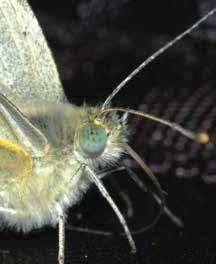
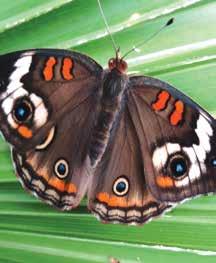
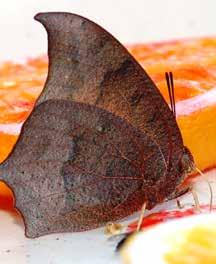
color vision of all animals, including humans.
Speed and Agility
Most butterflies fly at speeds between 5 and 12 mph, but skippers have been clocked at over 35 mph! The seemingly aimless fluttering confuses predators, which are unable to predict the butterfly’s position. All four wings function as giant rudders for quick, sharp turns. Monarchs can make a 90 degree turn in less than one body length! Butterfly wings are proportionally huge with the largest ratio of wing volume to body mass of any flying insect. However, the hind wings are not used for flight and removing them does not affect a butterfly’s ability to fly. Current research suggests that the hind wings are merely for show, making the butterfly more conspicuous. This seems counterintuitive in a world filled with hungry carnivores. However, when a preda-
tor discovers that most of their catch consists of inedible wings, they may drop butterflies from their menu.
Toxicity and Distinctive Color Patterns
Neither plants nor animals want to be eaten so there are many examples of both evolving poisons in their tissues to deter diners. Butterflies need a warning system since just being poisonous won’t stop predators until they’ve taken that fatal bite. Many of the distinctive wing colors and patterns probably evolved as an early warning system. One nasty bite teaches a bird “Don’t ever eat an orange and black butterfly again.”
Camouflage and Mimicry
Daytime predators hunt primarily by sight and scientists now think that butterflies’ amazing colors evolved as a protection from being
eaten rather than for species and gender recognition. Camouflage hides the butterfly when wings look like a dead leaf or tree bark. Mimicry is the opposite strategy, using bright colors to announce a warning. The palatable Viceroy’s near perfect copying of the poisonous Monarch’s orange and black wing colors protects it from potential diners.
Summary
Hungry predators are not the primary risk to butterflies in our modern word. All pollinators are in danger due to three general environmental threats: loss of habitat, wide-spread use of pesticides and climate change. Can butterflies adapt to survive these threats? The history of butterflies provides hope because they have repeatedly evolved to improve their survival rates. Evolution continues today, and if time allows, hope also continues.
The Healthy Gardener How Does Your Garden Grow?
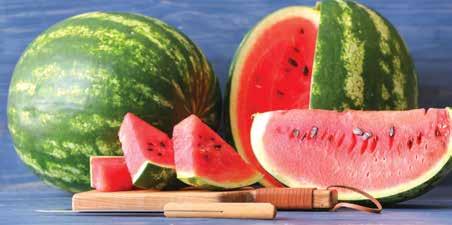
It is no secret that working in the garden improves mental and social well-being, and gardening is great exercise too. Many of you worked hard all summer to grow fruits, vegetables, and flowers. Now as summer wanes, and fall is on the doorstep, it is a time to enjoy all the fresh vegetables and fruits. This waning season is also a good time to pause and think not only about exercise, and mental well-being, but also about how you fuel your body. In other words, “how does your garden grow?”
For example, is there anything better than a tomato from the vine? The vibrant red color of tomatoes is from lycopene, an antioxidant that can help protect against inflammation. Corn is also a great summer option. Corn is high in both soluble and insoluble fiber. Both types of fiber play a role in supporting gut health and in controlling cholesterol levels. Swap out those sugary foods and drinks for the natural sweetness of fruit and get your vitamins and minerals in too. Watermelon is rich in vitamins A and C. Vitamin A is a nutrient the body needs to support growth, vision, and cell function.

Vitamin C is vital for healthy blood vessels, cartilage, muscle and collagen in bones. And it plays an important role in the healing process.
If watermelon is not your thing, there are always peaches and nectarines. Both are good sources of vitamin c, and they also have lots of potassium, calcium, and fiber. The beta-carotene found in both peaches and nectarines helps to reduce inflammation and improve immune function. Beta-carotene may also reduce the risk of cancer because it controls the growth of certain kinds of cells.
In fact, diets that are high in fruits and vegetables are linked to a decreased risk of multiple cancers including colorectal, stomach, lung, and mouth cancers. Foods high in fiber may lower the risk of colorectal cancer.
The options for healthy eating from the garden at this time of year are so wide and varied, there is not enough room in this article to write about them. I will close this article by wishing you all enjoy delicious (and nutritious) fresh fruits and vegetables throughout this season and all the seasons to follow.

TRACY GRAYBILL Field Specialist
Tracy is in Community Health with the Univ. of Missouri Extension-Community Health Engagement and Outreach. Email her at graybilltl@missouri.edu for more information.

Plant Spacing for New Gardens
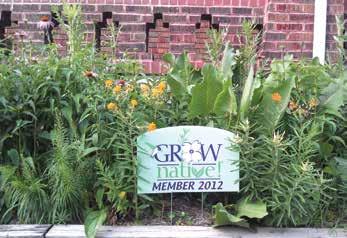
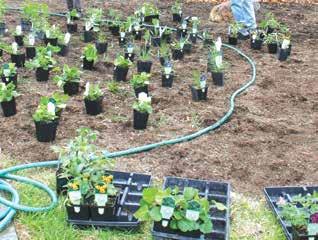
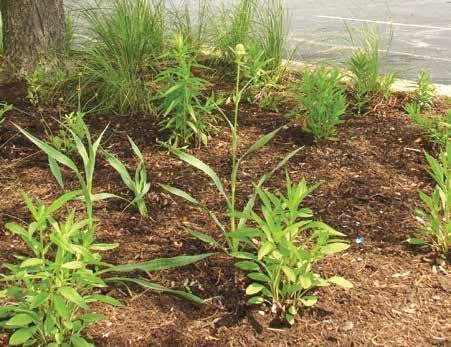
When planning a new garden bed, spacing plants can be tricky. There are many factors that go into deciding the distance between plants. Lowbudget gardens tend to have wide spacing and fewer plants. Higherbudget plantings bring plants closer together and have greater numbers. Conventional style uses wide spac-

ing, like an archipelago of plants in a sea of mulch. Natural-style gardens are tightly spaced, so that plants fill in quickly. Lastly, conventional and commercial gardens thrive on simplicity, resulting in low diversity. In stark contrast, naturalistic and fine gardens often strive for the greatest amount of diversity and quantity of plants.
To illustrate cost, let’s crunch some numbers. A 200 ft.² bed planted with 3-foot spacing needs 26 plants, costing $260 if you purchase a quart container for $10. The same 200 square-foot garden, planted at 2-foot spacing, has 58 plants at a cost of $580 for the plants. And lastly, the same bed planted at 18-inch spacing requires 103 plants at a cost of $1,030. Keep in mind that this is just the cost of the plants. If you had somebody design the garden, dig the bed, install and mulch, the total cost would be dou ble or triple the cost of the plants.
and might have 20 species—a dramatic difference if you’re planting only 200 ft.²
Why does plant diversity matter? Sometimes it doesn’t. Low-priority areas are often planted with a monoculture of ground cover plants that spread and grow thick to crowd out weeds. If the ground cover is successful, maintenance is greatly reduced.
But higher priority areas in view of porches, patios, and walkways usually get more attention—and plants. Here, beautiful and diverse gardens are worth the extra effort. This is where we tinker with texture, density, and height variations, and with color layering. The possible combination of plants is endless, and the greater number of species may result in greater visual interest. Here’s where an experienced and creative designer comes in handy.
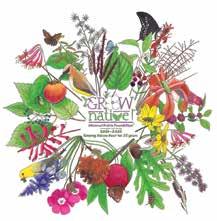
Plants installed with 3-foot spacing have oceans of mulch between them, and it might take 3 to 4 years for plants to grow together. Spacing like this typically has 4 to 6 species in the design. By contrast, gardens with 18-inch spacing have a grow-in period of one to two years
Diverse gardens also attract a wider variety of birds, butterflies, and bees that come to feed, nest, and lay eggs. The more plants and plant types, the more wildlife they attract. So spacing matters—especially close spacing.
I like to plant on 18-inch centers. Some plants end up closer and others further apart, depending on their habits. Large plants like ironweed and Joe pye need more room (2 to 3 feet), though they can be leggy and benefit from palm sedge on their heels, like a skirt on a tall ballerina.
Scott Woodbury was the horticulturist at Shaw Nature Reserve for 30 years and stepped down from that position in June 2022. He continues to work on contract for Shaw Nature Reserve to carry out native landscaping education and has launched his own business called Cacalia: Native Garden Design and Wilding. Find suppliers of native plants, seeds, and services at the Grow Native! Resource Guide: www.moprairie.org.
Small plants like alumroot need only 12 to 14 inches, though I usually tuck them in between other bigger plants.
It’s easy to get lost when trying to work out spacing, but I find that when I keep things simple, stick to 18-inch spacing for all the perennials and grasses on my plant palette, spacing works out fine. Some designers choose wider spacing, while others aim for tighter arrangements. It’s often a matter of personal taste. A planting or ground cover calculator is a helpful tool for spacing decisions. A useful one can be found at classygroundcovers.com. You plug in the square feet of the bed (length multiplied by width) and the spac-
ing you choose, and it gives you the number of plants required. Be sure to subtract 5 to 10 ft.² for each tree or shrub that you are planting within the bed. Also subtract any pathways or non-planted areas. For larger, irregularly shaped beds, Google Earth is useful. Google Earth is a program that you can download for free to your computer. First generate a polygon layered over a satellite image of your property. The program will automatically measure the square footage of the polygon, or the bed. It is less accurate than measuring in person, but it will get you close enough. Remember that spacing is subjective and is not an exact science—like life! Happy gardening, y’all!
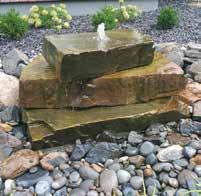






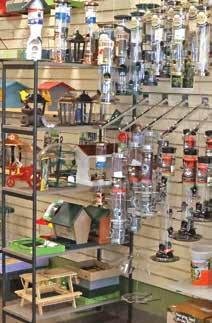




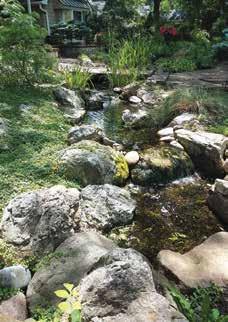

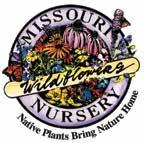
Meet us at one of these locations in the KC area. Give
and we’ll
Platte Land Trust Native Plant Sale at Backyard Bird Center, 6212 NW Barry Rd. KC MO 64154. www.plattelandtrust.org. September 6, 10 a.m. to 2 p.m
Missouri Prairie Foundation Native Plant Sale at Anita B. Gorman Conservation Discovery Center, 4750 Troost Ave, Kansas City MO 64110. www. moprairie.org. September 13, 10 a.m. to 2 p.m.
Deep Roots Native Plant Sale & Habitat Garden Tour. City of Prairie Village Municipal Offices, 7700 Mission RD, Prairie Village, KS 66208 deeprootskc.org. Sept. 13, 10 a.m. to 2 p.m.
Shawnee Indian Mission Foundation - Fall Native Plant Sale at Shawnee Indian Mission, 3403 W. 53rd St, Fairway KS 66205. shawneeindianmission.org. September 27, 9 a.m. to 1 p.m.
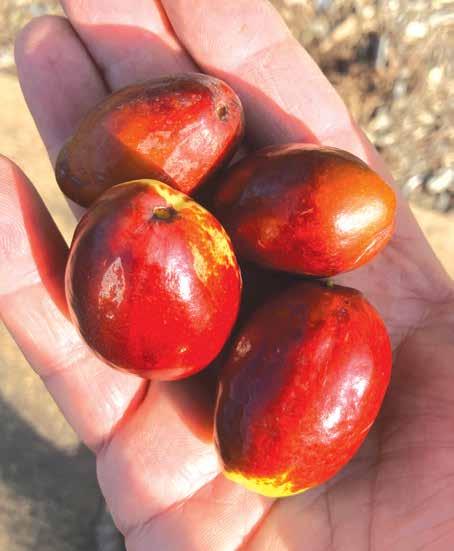
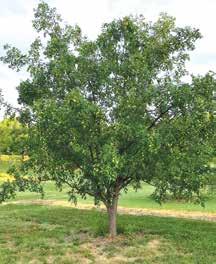
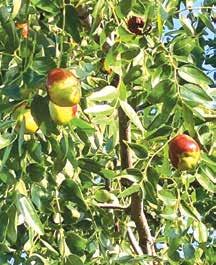
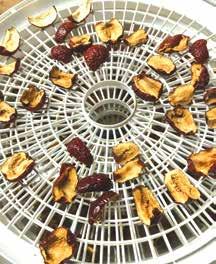
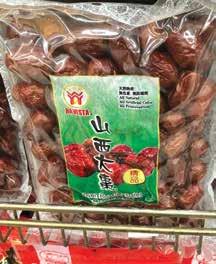
What is a Jujube?
If you know the answer to this, please don’t stop reading. If you don’t know the answer don’t assume it is just a movie candy, this is an article about growing fruit. The movie candy Jujubes (now apparently extinct) was named after the fruit and was first developed as a commercial sweet treat in the early 18th century. The Latin name, that is another mouthful, Ziziphus jujuba, rolls of the tongue, and is fun to say, Zi-zi-fus. As for the common

name pronunciation, it is technically Joo-joob, if you add the last syllable Joo-joo-bee, that is okay, but you may seem midwestern if you vocalize this in other parts of the world. If you fear bad juju, you could also call it a red date, or Chinese date, but then that might confuse the issue too, this plant is in no way related to a date. So, what is this unusual fruit and why should you care?
The tree and fruit has a long human history dating back at least 9000
years. It is considered native to Central China and was spread to Korea and Japan 2000 years ago and west via the Silk Road. Billions of people know this fruit! In the U.S. the jujube is a relative newcomer, introduced nearly 200 years ago it gained more attention in the early 1900s through the fruit explorer Frank Meyer. Kansas City’s history is very young with this plant. I was first introduced to this tree on an Alan Branhagen tree walk at the Linda Hall Library
Arboretum in the mid-2000s. Sadly that tree, and another tree in Loose Park are no longer there. But my curiosity was stirred, glossy leaves, a rather contorted growth habit and edible fruits with a unique taste and texture. As I got deeper into (unusual) trees I discovered the Champion Trees Of Greater Kansas City, a document started by arborist Chuck Brasher (remnants of this list survive, and Heartland Tree Alliance has a link to an updated list here
Matt Bunch is The Giving Grove program director for Kansas City Community Gardens and Horticulturist for The Giving Grove’s national network. For more information about Kansas City’s Giving Grove program, visit www.kccg.org/giving-grove.
(https://bridgingthegap.org/kc-metro-champion-trees/), and on that list was the Metro Champion Jujube, located on a traffic triangle at West 71st Terrace and Cedar in Prairie Village (a site to behold). Later in the 2000s with the start of Powell Gardens’ Heartland Harvest Garden, many varieties of jujube (Li, Lang, Black Sea, Autumn Beauty, So, Winter Delight…) were planted out in the garden. The jujube renaissance has begun.
Jujubes are well suited to our area. The glossy leaves are a sign of drought tolerance, they have very few pest issues, are 4-10 times higher in vitamin C (by weight) than oranges, and there are many varieties that produce great tasting fruits. Having few pest issues makes this fruit desirable to grow, but this quality can also lead some to question its invasive ability. The seeds are not able to be spread by birds (as opposed to Callery Pear), and the seeds have a double-dormancy that makes germination difficult. Jujubes do have thorns, which is a downside, but some varieties like Lang, have few to no thorns. Jujube rootstock, which is typically a seedling, does tend to send rhizomatous shoots (suckers) a few feet from the trunk, these are typically cut off or mowed over. The tree is notoriously late to break dormancy, often late April or May, and does not flower until June. While the flowers are almost insignificant the heavenly scent is truly a delight.
What about the fruit? Most cultivars are 1-2.5”, some are round, some oblong, Z. jujuba is about 1/2”-3/4” round, with a tangy punch. The fruit has a pit, like a date (hence the common name) or an olive. The flesh surrounding the seed is often crisp white when firm, and can vary in sweetness, often being super sweet like the variety “Sugar Cane”. As the fruit ripens on the tree going from green to mottled green-brown to full brown the fruit can soften. It is at this softening stage that some varieties take on a more nuanced apple-pie type flavor. Many who breed and study jujubes classify the fruits
as either for fresh eating or dehydrating. Dehydrated jujubes seemingly last forever and have many medicinal and culinary uses. Mine typically go into a snack mix or oatmeal. If you are looking to grow jujubes know that they require full sun, and you need two separate varieties to ensure pollination, although “Li” is self-fertile. Most cultivars tend to mature at 15-20’ wide and 20-30’ tall. Varieties to consider for Kansas City:
• Li — 2” large round fruits. Variety is best suited for fresh eating and is self-fertile. Big crops.
• Lang — 1-1.5” oblong fruit. Tends to be better for dehydrating. Nearly thornless. Big crops.
• Sugar Cane (Coco) — Very sweet, fresh eating, with a coconut aftertaste, round fruits 1-1’25”. Unfortunately thorny.
• Autumn Beauty — 2” oblong fruits are sweet and crispy, good for fresh eating.
• So (Contorta) — Tree is well rounded 20x20 and has a contorted growth habit. Fruits are 1.5” round.
• Chico — 1-1.5” sweet fruits for fresh eating.
• Honey Jar — 1.5” sweet oblong fruits for fresh eating.
To see some of these cultivars that were planted in 2008-2009, visit the Heartland Harvest Garden at Powell Gardens (Jujubes ripen in September and October!). The Kauffman Community Orchard (south of the Missouri Department of Conservation Discovery Center at 4750 Troost) features Li and Lang planted in 2013 and Chico, Honey Jar and Sugar Cane planted in 2022.
To learn more about Jujubes varieties visit: (https://jujube.nmsu. edu/index.html).

Fall color worth planning for When the Garden Glows
When you hear the word “Fall,” many things come to mind. Hopefully cooler temperatures, football, crisp nights by the fire pit, leaves changing, and the garden slowing down in preparation for winter. Planning your landscape and garden for four seasons of beauty is so important and fall foliage is often overlooked. We often think about trees changing colors, but do you really think about shrubs or perennials? These are some of my fall favorites in the two categories.
Fothergilla is an underrated shrub that does well in part sun or part shade. There are some different options on size for this plant. An older variety is ‘Mt Airy’ which can be three to six feet tall or a smaller ‘Jane Platt’ or ‘Legend of the Small’ that only get two to three feet tall. Whichever variety you choose, you will be rewarded with white bottle brush flowers in the late spring and early summer. The flowers are great for pollinators. The real showstopper is their foliage with luminescent orange-yellow leaves. They glow in the late afternoon sun. Something to consider when planning your fall landscape is how the light illuminates those fall leaves. Where will it truly glow? Make sure you are giving the correct light for the plant to be happy, but you should consider how it will make you happy too. These shrubs are extremely low maintenance in addition to being beautiful. They handle tough soils, drought, and extreme temperatures with ease.
Oakleaf hydrangeas (Hydran-

gea quercifolia) are planted for their spectacular cone shaped flowers, but their fall color is often overlooked. The deep and beautiful red-burgundy color on the large oak shaped leaves is stunning. Most likely, you are watering your oak leaves to keep them happy during the summer months, which helps them have gorgeous color in the fall. There are many options of varieties to choose from, from small to very large. Make sure you do your research and find the best one to fit your landscape. ‘Ruby Slippers’ is one of my favorites, and not just for its name. Getting three to four feet tall and wide, it fits well in the garden. The blooms start out white then turn a lovely pinkish, mauve color. The Gatsby series from Proven Winners has five varieties, ‘Gatsby Moon’ is very intriguing because the flower petals are extremely tight, unlike most other oak leaves that are more open. It resembles a cone shaped sponge. If you have a spot in your garden that gets morning sun and afternoon shade, you should give one of these a try.
I could write this entire article just on Viburnums and their fall color options—maybe in another issue. They truly are an amazing and diverse genus of plants. They have such a wide variety of flowers, scents, berries, size ranges, and last but not least, foliage colors. I would recommend doing a little research on these wonderful groups of shrubs. There is truly a type of Viburnum that everyone could enjoy for some attribute or another. I will
say, Viburnum plicatum ‘Copper Ridges’ is one of my favorites for fall color. It is a rich copper-red. You can find them at Serenity Point at the Overland Park Arboretum & Botanical Gardens.
Perennials also have some great fall color. What if I told you there were native grasses that had spectacular fall color? I don’t think you can miss with either kind, Big Bluestem (Andropogon) or Little Bluestem (Schizachyrium). Both are outstanding for fall color in the full sun areas of your garden. They are also tough, drought tolerant, and very well behaved—no flopping on their neigh-
bors. You do need to pay attention to where you are placing them. Big Bluestem can reach six to eight feet tall, where Little Bluestem is three to four feet tall. There are also color variations of Big Bluestem. ‘Red October’ leans more towards red fall color, where ‘Blackhawks’ is more dark purple with a red tinge. ‘Holy Smoke’ is kind of in between, it’s not as dark as ‘Blackhawks’ but has more red in it. If you are better-suited for a Little Bluestem, you cannot beat ‘Standing Ovation,’ it is a mixture of red and orange with a slight bit of dark purple. A newer variety on the market is ‘Blue Paradise,’ if
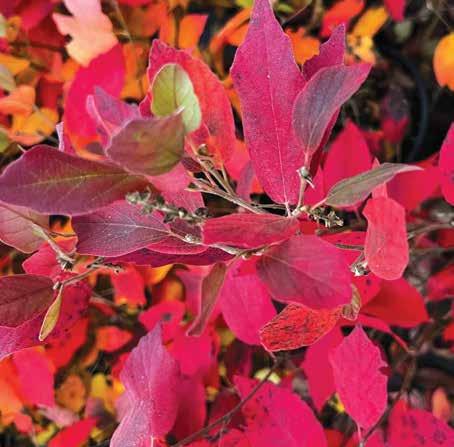
you are looking for hot coppery, orangey red then don’t look past this plant.
Amsonia or commonly known as Blue Star is another multi-season interest plant. It has icy blue blooms in the early summer but in the fall the foliage turns a glowing gold. It will achieve the best fall color in full sun, though the plant is fine growing in part sun/partial shade. There are different species of Amsonia. I personally enjoy Amsonia hubrichtii more, it is the Threadleaf Amsonia. I love the delicate thin foliage and the movement it brings to the garden. When the sun hits it right it looks like gold thread in the fall garden. As with the other plants discussed today, there are many options to choose from, make sure you understand the size of the plant you are selecting. Whichever species you choose, they are very easy low maintenance perennials that do great in our region.
If you don’t have a big garden space or are looking for a new groundcover to try, Plumbago (Ceratostigma) is an excellent choice. It has true blue flowers in the summer, which is hard to find in the summer on a perennial. But the fall color is spectacularbright, vibrant, knock your socks off, red. The red color does show more when the plant receives afternoon sun. It is very drought tolerant once it is established. It can be planted in full sun to partial shade. Flowers and fall color are less vibrant in lower light conditions.
Fall is still a great time to plant. Soil temperatures are warm and plants can sometimes get rooted faster than they do in the spring. Do make sure you are giving them extra care if our temps get toasty. We can still get into the 90s in September. You may also get better deals from local nurseries or garden centers. They want to reduce the inventory they have to care for over the winter. Better you take care of it than them! So go shopping and find some new fall foliage favorites for your garden. Sit in your garden and think about where these foliage favorites will make your garden glow.
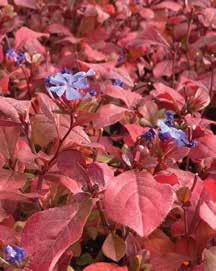
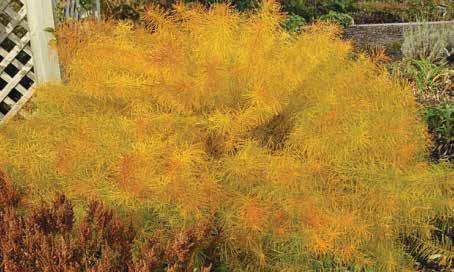
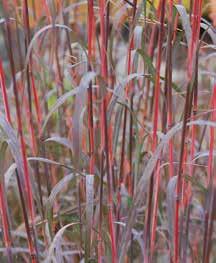
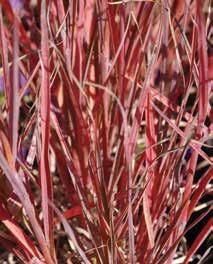
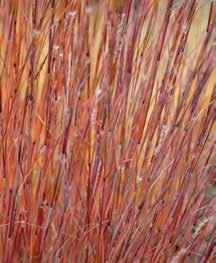
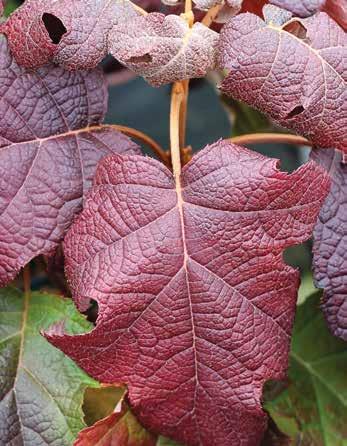
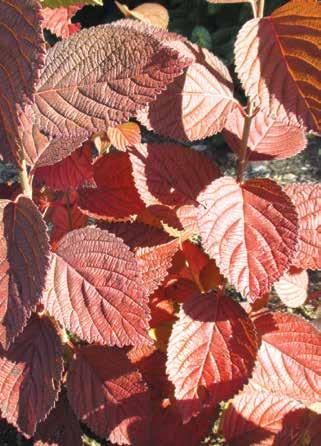
Rose Report
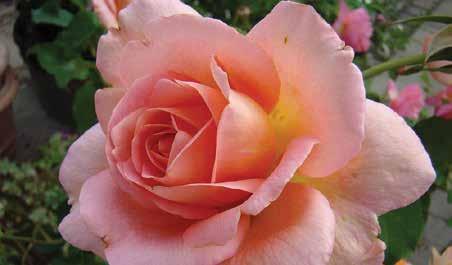
Welcome to September!
In my opinion, this is the best rose month of the year. The roses are recovering from the summer heat, Japanese beetles, and other summer maladies, and are poised for their final, most magnificent flush of blooms of the year! Yes, they were lovely in June, but the bushes were still small from spring pruning. Now, they have had all summer to grow tall and sprout many canes, each of which will produce a bouquet of blooms. This last flush will last until the first hard freeze. Once, I had roses on my Thanksgiving table!
Do not fertilize any more this year and stop deadheading. This will encourage the plants to prepare for winter. Otherwise, continue watering as needed to maintain one inch a week. Keep up your fungicide treatments if you grow susceptible varieties. And keep an eye out for late summer insects and treat as needed.
A rose by any other name…
One of the joys of roses is their fragrance. Here are some interest-

ing rose fragrance facts. Fragrance comes mostly from small scent glands on the rose petals. Roses are most fragrant in the morning and evening, and when there is slight humidity, the aroma lingers in the air. The scent may change from rose bud to fully open flower, or if the rose is not getting enough water or fertilizer. Not everyone has the same sensitivity to scent, and different people may describe the same rose’s fragrance using different descriptive terms. It is like trying to describe the taste of wine. There is a standardized system of categorizing rose fragrance with five main scents: Old Rose, Myrrh, Fruity, Tea and Musk. While a few roses smell strongly of just one category, most have a combination of scents that create a blend unique to that variety. Rose tags, catalog entries, and online rose suppliers usually include the strength of the fragrance ranging from none to very strong, and a description of its scent. Here are some description examples for roses growing in the Laura Conyers Smith Rose Garden, taken from the spring 2025 Edmund’s
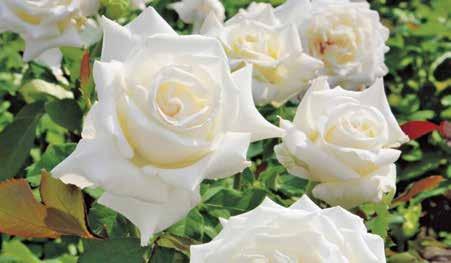
Roses catalog www.edmundsroses. com.
• Moonstone—mild, tea
• Easy Does It—moderate, fruity
• Memorial Day—strong, old rose
• Dee-lish—very strong, citrus
Although we love fragrance, it is not recognized in traditional rose shows which award prizes to the most beautiful roses, whether they are fragrant or not. In 1957, Dr. James A. Gamble, a rose enthusiast who wanted to encourage hybridizers to breed more fragrant roses, endowed an American Rose Society award for fragrance. Since 1961, 28 roses have received the James A. Gamble Fragrance Medal. Here is a list of the award winners, and year of award, growing in the rose garden: Beverly (2002), Chrysler Imperial (1965), Double Delight (1986), Falling in Love (2012), Granada (1968), Mister Lincoln (2003), Pope John Paul II (2019) and Tiffany (1962). Next time you visit the rose garden, take a fragrance tour to find these award winners, and notice the range of fragrances in other roses in
the garden. Garden maps (with the Gamble winners in bold) are available at the east entrance. You can find information on the roses listed here and all the roses in the rose garden by visiting our website, www. kansascityrosesociety.org and clicking on Rose Library. While you are in the rose garden, click on the QR code on each rose bed sign to be taken directly to the library entry for that rose.
If you have questions about roses, our Consulting Rosarians are available by sending an email to RoseHelp@kcrosesociety.org.
September events in the rose garden
Find information on these events and all our activities by visiting www.kansascityrosesociety.org.
September 7, 5-7pm Jazz in the Roses FREE public event. Bring your picnic basket and enjoy the music.
September 18, 5:30-7:30 Wine & Roses annual fundraising gala to support the rose garden, our educational activities and outreach programs.
Laura Dickinson is an American Rose Society Master Consulting Rosarian and President of the Kansas City Rose Society. She has a special interest in low maintenance roses and encouraging reluctant gardeners to give roses a try. Her motto is: Roses are easier than tomatoes.
Kids Ask Dr. Bug
Is it true that an insect can trick a plant into growing a house?
Yes! Gall wasps are tiny insect architects. A female gall wasp stings a leaf or stem, not to hurt the plant, but to lay an egg. That sting releases chemicals that send a message to the plant: “Grow something weird.” And the plant listens!
It might grow a fuzzy ball, a hard knob, or a leafy lump, each shape depends on the wasp species. These structures are called galls.
Inside that gall? A baby wasp, tucked in safe from predators and surrounded by food. Most gall wasps don’t hurt the plant, and the galls themselves are a bit like insect mystery pods, just waiting to hatch.
Dr. Bug, if I go outside right now, what bugs might I see doing something awesome?
While the days are long, flowers are blooming, and if we have had some rain recently, the air will be buzzing with insect action. Some insects are pollinators. Some are hunters. Some are nature’s cleanup crew. And some are doing things strange enough to almost sound made up (but I promise – it’s real!).
Here are just a few fantastic insects you might spot this month:
• Swallowtail caterpillars: Check parsley, dill, or spicebush for a chunky green caterpillar with fake eyes on its back. This is a baby butterfly! If it gets scared, it’ll pop out two tiny orange horns and release a stinky smell. In just a few weeks, it’ll become a big butterfly with long “tails” like a bird.
• Dragonflies & damselflies: These zooming hunters look like tiny flying dragons, and

they’ve been around longer than the dinosaurs! Dragonflies dart over ponds and fields, eating mosquitoes and gnats mid-air.
• Hoverflies (aka “fake bees”): See a little bee-like insect hovering like a helicopter? It might be a hoverfly. They look like bees to trick predators, but they don’t sting. Their babies gobble up aphids in the garden. Hoverflies are super helpful!
• Gall wasps & parasitoid wasps: Some wasps don’t build nests at all. Gall wasps (see above!) convince plants to grow protective homes. Parasitoid wasps lay their eggs inside caterpillars or aphids. Yes, it’s intense, but this is nature’s built-in pest control!
• Tiger beetles & leafcutter bees: Tiger beetles are like shiny green racecars on legs. Watch them flash and dart across sunny trails. Leafcutter bees are more artistic – they cut nearly perfect circles from leaves to build cozy nests for their babies. If you see neat holes in leaves, don’t worry. That’s a bee at work!
• Katydids, cicadas, and crickets: Some critters are LOUD this time of year as they all sing at once! Each insect makes sound for a different reason: to find a mate, to scare predators, or to say, “This is my tree.” Try listening with your eyes closed. Can you tell who’s calling?
Send your questions: https://bit.ly/KidsAskDrBug
Play the firefly-catching game: https://bit.ly/CatchFireflies
TAMRA REALL
Horticulture Specialist
Dr. Tamra Reall (@MUExtBugN Garden) is the horticulture specialist for MU Extension in Jackson County. For free, research-based gardening tips, call 816-833-TREE (8733).




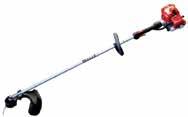





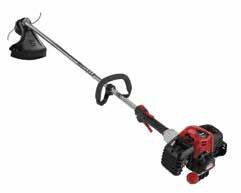

Daylilies: The Path to Many Gardens
After becoming empty nesters, we found more time on our hands to discover our own interests, hobbies, and things we can do together. We have always both loved plants and it became natural that gardening has become one of our favorite hobbies. We enjoy antiquing and spending sometimes hours at auctions and exploring various estate sales. We seem to be looking for unique glassware, outdoor decorations or garden pieces, mostly items in need of repair. Stephen has a talent to turn an old piece of décor, whether it be plastic, metal, or concrete into a new improved addition to our garden and home.
Stephen had about 25 cultivators on his 80-acre homestead near Hoyt. I had yellow daylilies that my father had given me over the years and several perennial flowers, but our interest consisted of picking things that were simple plants. During Covid (2020) as many people were looking for tasks that didn’t involve going to public places, we spent time clearing trees and working on landscaping around the home. Stephen spent hours eradicating dandelions and clover on the 5 acres that we call our ‘yard’. While this may seem extreme, we have prairie hay and brome hay fields that bees and other insects thrive on. We found a Facebook marketplace advertisement for daylilies for sale in Topeka. We purchased our first eight joint daylilies and built our first of many gardens right off our driveway. This first garden replaced the driveway basketball court. The next summer we purchased more cultivars and built a garden around what we now call the flagpole garden. This gar-

den started with just six around the pole, but slowly has extended down our gravel driveway and expanded to three rows of registered daylilies. We continue to purchase from this same local backyard garden seller and some of our best and favorite plants came from him. He also introduced the world of hybridizing
lection and encouraged our interest. We heard there were daylily clubs in our area, but they introduced us to the National Society and other society officers living in our area. We learned the world of Daylily was much larger than we ever thought possible.
We are now American Daylily
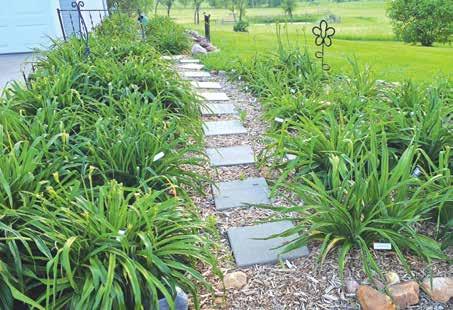
to Stephen and over the years has become one of our greatest sources of daylily knowledge.
Each summer we add more daylilies and perennial flowers to our garden. We purchase from garden stores, nurseries, and continue to purchase from sellers and hybridizers on Facebook that sell from their personal gardens. We love a good road trip and do not hesitate to jump in the car on the weekend and find a new garden, nursery, auction or estate sale.
A few summers ago, we met a lovely couple with a beautiful garden in Wamego. Over the last few years, they helped us grow our col-
Society members and also members of Topeka Daylily Club and Mo-Kan Daylily Society. We have attended two Region 11 Spring Gatherings in Joplin, Missouri, the 2024 American Daylily Society National Convention in Oklahoma City, and numerous club activities. We enjoy meeting daylily fanatics, and feel this network of people and knowledge has been the best tool to help grow our hobby. They are one of the easiest plants to grow in Kansas, especially clay soil. We encourage others to join a club, attend the meetings, and get involved in the activities the clubs host. For us the historical knowledge within the members of
the clubs and presenters at meetings has been such a big part of keeping us addicted and learning more along our daylily adventure.
Several years ago, we purchased seeds from a hybridizer with a great reputation for selling a quality product. Stephen developed his own hybridizing process through trial and error. The seeds he crossed for the last three years are now growing in our back yard beds. This year will be the first year to see blooms on the initial seeds from three years ago. We have learned some summers will be plentiful with seed production and some will not. This was our reason we decided to purchase seeds online to add to our program. Fluctuation of Kansas weather and temperatures are not always cooperative to hybridizing but this just makes the challenge more exciting.
We will remain involved and active and soak up all of the knowledge we are lucky enough to have locally in Region 11. This summer, we plan on attending local garden tours, Region 11 summer meeting in St. Louis, and of course continue work in our gardens. We will continue to add new and old cultivators in our garden until we run out of room, but that may be a while, we seem to always find more space! Stephen will be happier playing with the pollen on the daylily blooms rather than mowing as we continue to eliminate ‘the yard’.
The Mo-Kan Daylily Club will have a Public Sale of double fan daylily bundles on Saturday, September 6th at 8:30 a.m. until 3 p.m. or until sold out. Cash or Credit Only. The sale will be held at Loose Park Garden Center, 5200 Pennsylvania Ave., Kansas City, MO 64112.
JENI EFIRD | DAYLILY GARDENERS | STEPHEN FENSKE
Jeni and Stephen are longtime Midwest gardeners with a deep fascination with daylilies.



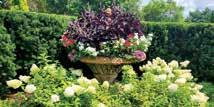










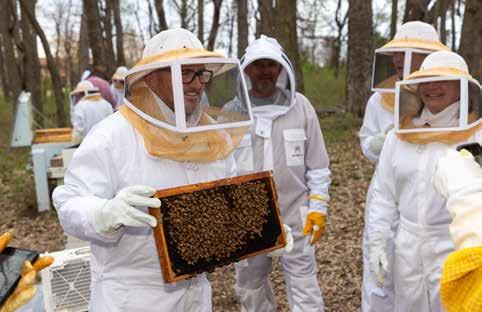

Courses
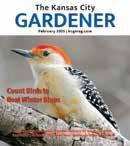





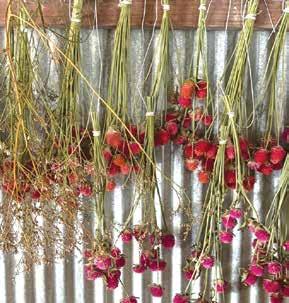
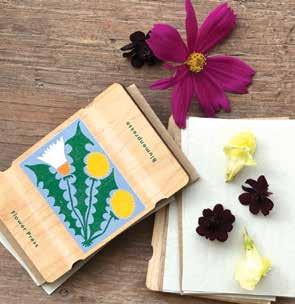
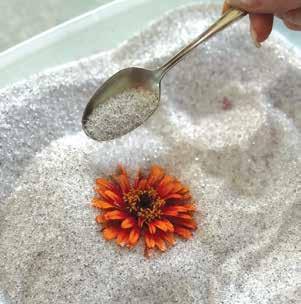
Drying Flowers from the Garden
Part of the joy of gardening is bringing fresh-cut flowers indoors. You can enjoy blooms beyond the growing season by preserving them for everlasting bouquets, wreaths, cards, and other crafts.
We preserve flowers using three methods: hang drying, pressing, and silica gel drying. Select the appropriate technique by considering the structure of the flowers you wish to preserve and the intended use of the dried material.
Hang Drying
Hanging bundles of fresh-cut flowers is the easiest method for preserving flowers. Blooms with a strong three-dimensional shape like gomphrena, marigolds, globe thistle, rattlesnake master, and calendula are especially suited to hang drying. Lavender, eucalyptus, roses, hydrangeas, yarrow, statice, sunflowers, and many native plants

including salvias, goldenrods, and asters are great candidates. Don’t forget grasses, grains, and seedpods for bouquet and wreath accents. Kitchen herbs can also be dried in this way.
Prepare cut flowers by removing leaves, unwanted blooms, and branching stems with sharp scissors or garden shears. Gather flowers together in bundles. You can dry bunches of the same flower and create an arrangement once dry, or create an arrangement and dry it all together. Grab the stems, cut them to equal length, and secure the ends with a rubber band as tightly as possible. Cover the rubber band by wrapping it with twine and securing it with a square knot. Use the excess twine to hang your bundles in a cool, dry, dark place. Flowers are ready when they’re completely dry. Try breaking a stem to test readiness. If it snaps, it’s ready. If it bends, it needs more time.
Pressing
Pressing works well for composite flowers and blooms with a pliable core that can be flattened. Pansies and violets, cosmos, salvia, geraniums, hostas and dianthus are all great flowers for pressing. Use a flower press or improvise by using cardboard and paper between heavy books.
Prepare flowers by removing any unwanted stems and leaves. It can be useful to dissect a flower and reassemble it for display after pressing. If petals fall you can simply press them and arrange once dried. Make sure flowers are free of surface moisture.
Start by filling your press in layers. Put down a piece of cardboard, a piece of paper, flowers, another piece of paper, and repeat this layering process until all your selected blooms are used up. Close the press or stack books on top until everything is firmly flattened.
After about a week, you can open your press to check your blooms. If they aren’t dry, simply reassemble the press and give them more time. When they’re ready, you can use pressed flowers for cards, framed artwork, coasters, bookmarks, jewelry and more.
Silica Drying
Silica is a mineral desiccant that absorbs moisture quickly, preserving the color and three-dimensional form of flowers. Using silica gel requires some initial investment in supplies, but they are reusable. You will need an airtight tub large enough to hold flowers with stems and plenty of silica gel to cover them.
The best flowers to preserve using this method include zinnias, sunflowers, snapdragons, dahlias, and mums. Many native plants like gaillardias, sunflowers, and coneflowers can also be beautifully preserved this way. Start by removing
Amy Albright is Co-Owner of Vinland Valley Nursery, a full service organic nursery and greenhouse south of Lawrence, KS offering hundreds of annuals, herbs, perennials, shrubs and trees, including a vast selection of native plants. Emma Davison is Assistant Manager in charge of special events. She also teaches workshops, builds displays and manages the large U-Pick cutting garden.
stems and leaves. Next, wire flowers by pushing the floral wire through the underside of each flower until it comes out the top. Taking the wire that has come through the top, measure roughly a centimeter down, then bend at a 60-degree angle so the bend points back down towards the flower. Take the wire that remains on the bottom part of the flower and gently pull down so that the bent piece disappears into the bloom.
Pour a 1-2 inch layer of silica crystals to cover the bottom of your drying tub. Nestle flowers face up in the silica gel. Curl the wire up under the flower or bend it around so it can be used to find the flower more easily. Add silica gel a little at a time to

the top of the flower, using a brush and gently shaking the vessel to be sure that all the nooks and crannies of each flower are packed with gel crystals and completely covered, then seal with a lid.
Leave the covered container for at least three days. Flowers left in silica for more than 7 days may become overdried and brittle. Silica gel is reusable! When crystals turn green, they’re full of moisture. To return them to an absorbent state, bake in an oven at 250° until their orange color returns, usually about 1-2 hours. Silica-dried flowers last up to 5 years and can be used for dried bouquets, shadow boxes, wreaths, resin crafts, and more.

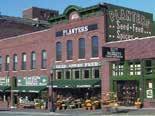

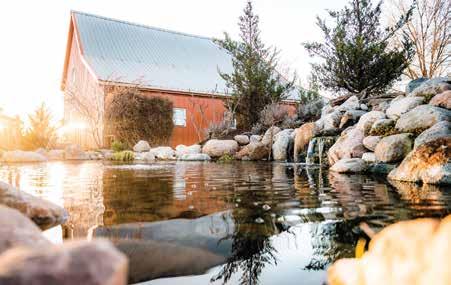



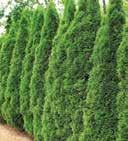




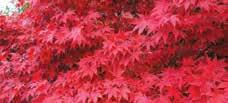
Invitation to ‘Hasta Luego Monarchs’ event at the Pollinator Prairie

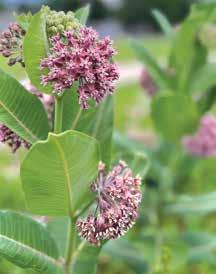
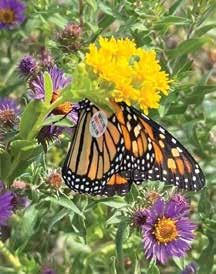
Monarch butterfly season is here. Did you know that each fall, thousands of monarch butterflies migrate through the Kansas City area? They can be seen in flight or sipping nectar from flowers, or roosting in trees. Some travel as far as 3,000 miles from southern Canada or the northern United States to overwintering grounds in Mexico. In celebration of this incredible insect and the amazing journey south, the Johnson County Extension Master Naturalists and Monarch Watch together host an annual community event at the Pollinator Prairie in Olathe. On Sat., Sept. 27, from 9 a.m. to 1 p.m. the public is invited to attend “Hasta Luego Monarchs.” This free event features interactive booths and exhibits, including games for children and engaging information for all ages.
Monarch Watch, an education, conservation, and research organization, based in Lawrence, Kansas,

will be back again with live butterfly tagging demonstrations. Monarch Watch describes its monarch tagging program as a “a large-scale community science project.” The project “was initiated in 1992 to help understand the dynamics of the monarch’s spectacular fall migration through mark and recapture.” Since then, the program has tagged millions of monarch butterflies, and every year, more data is recorded for research purposes. Volunteers will be tagging and releasing monarchs during the event, and attendees can see citizen science in action.
Another favorite with visitors is the “Caterpillar Wonders” exhibit presented by the Johnson County Extension Master Gardeners. Younger visitors gravitate to this booth to see real caterpillars and learn about insect life cycles.
The event celebrates more than just monarch butterflies. While monarchs are making their journey,
GINNY VARRAVETO
many migratory birds are also on the move, heading south to their winter breeding grounds. Prothonotary Warblers, Purple Martins, and some nonresident Bluebirds are all migrating south at this time of year. Some of these bird species, such as Purple Martins, go all the way to the Amazon. A dedicated group of Extension Master Naturalists called the “nestbox stewards” monitors and provides habitat support for these birds. The nestbox stewards will have an exhibit at Hasta Luego Monarchs this year, featuring information on bird conservation efforts, what individuals can do to help support birds, and how nestboxes provide needed habitat.
Exhibits presented by Johnson County Extension Master Naturalists include displays and materials about native bees, caterpillars, bats, milkweed, natural pest control, water quality and rain andbarrels, and more. ways to help pollinators. The
Extension Master Naturalists provide information on simple things everyone can do to support nature, such as reducing the lawn and planting native plants.
Fall offers ideal conditions for planting many native plants. Native plant seed packets will be available for purchase, with some of the proceeds going to support the Extension Master Naturalist projects and conservation andas well as stewardship activities at the Pollinator Prairie. Native plants will also be available for purchase with from the local native plant nursery, Parsons’ Gardens.
Hasta Luego Monarchs is a volunteer-driven event, and a lot of creativity goes into making it a fun and engaging experience year after year. The event is a celebration of monarch butterflies, but it is equally a celebration of the conservation efforts at the Pollinator Prairie and the community that supports and enjoys this beautiful public space. Join the fun on Sat., Sept. 27, from 9 a.m. to 1 p.m. The event is free and open to the public. The Pollinator Prairie features an accessible paved walking path and is located at 320 South Blake Street in Olathe, Kansas.
To learn more about the “Hasta Luego Monarchs” event or the Pollinator Prairie, go to the Pollinator Prairie – Olathe, KS page on Facebook or the Johnson County K-State Research and Extension website (www.johnson.k-state.edu/ programs/natural-resources/extension-master-naturalist/pollinatorprairie/hasta-luega-monarchs/) or this short link (https://tinyurl.com/ yvjfp5md).
Upcoming Garden Events
Native Landscape Chat – Migrating Monarchs
Garden Club of Shawnee
Thurs, Sep 4, 7p; at Shawnee Town 1929 Town Hall, 11600 Johnson Dr, Shawnee, KS. Dawn Buehler, Kansas River Keeper and Executive Director of Friends of the KAW, will talk about their work protecting and preserving the Kansas River. This is also our fall plant, seed and bulb exchange. Snacks, door prizes. Visitors welcome!
Heartland Hosta and Shade Plant Society CANCELLED Sat, Sep 13
Leawood Garden Club
Tues, Sep 23, 10:30a; at Cure’ of Ars Catholic Church, 9401 Mission Rd, Leawood, KS. We are honored that our first guest Speaker will be Cameron Kincaid. He is the Senior Manager of the GrassPad in Olathe, KS. He is going to speak on “Turf Maintenance in the Fall”.
Leavenworth County Master Gardeners Club
Wed, Sep 10, 11a; at Riverfront Community Center, 123 Esplanade St, Leavenworth, KS 66048. GMO enthusiast Sindey Platz will discuss Demystifying Genetically Modified Organisms (GMO) and the effects in our gardening practice. The meeting is free. Visitors are welcome. Questions, contact the Leavenworth Co Ext office at 913-364-5700.
Raytown Garden Club
Tues, Sep 2, 10a; at Blue Ridge Presbyterian Church, 6429 Blue Ridge Blvd, Raytown, MO 64133. Program will be “Planting Ground Covers for the Benefit of Our Earth” presented by Michelle Livergood, Master Gardeners Speakers Bureau. Guests are always welcome. For more information please check out our Facebook page: https://www. facebook.com/RaytownGardenClub.
FESTIVALS
Old Settlers Community Flower Show
Fri, Sep 5 & Sat, Sep 6. Entries accepted: Thurs 9/4 6-8p, Fri 9/5 8-9a. Show Open for Viewing: Fri 9/5 1-8p, Sat 9/6 9a-3p. Location: 100 E Santa Fe St, Olathe, KS 66061 (Ground Floor) *Free & Open to the Public* both entries and viewing. Presented by the Olathe Garden & Civic Club in coordination with Olathe Old Settlers Days, this annual flower and horticulture show is for everyone to participate in and enjoy! Entries will be accepted from amateur (non-commercial) gardening enthusiasts. Look at the beauties in your garden, arrange them to fit a floral design class or just clip them and show them off as specimens! Bring them to the ground floor of the City Hall building and we’ll help you get entered, or just come by to see the beautiful entries!
Hummingbird Festival
Sep 4-6; at George Owens Nature Park, 1601 Speck Rd, Independence, MO 64057. Celebrate the Ruby Throated Hummingbird as they prepare to migrate. Presentations and activities scheduled throughout the weekend. All details found at (https://www. independencemo.gov/events/hummingbird-festival-day-1). Master Gardeners of Greater Kansas City will have family-friendly activities, demos and displays all three days, to help you learn why hummingbirds are such important pollinators. Free. Registration required for all events at www.webtrac.indedmo.org. Family friendly event. All children under 16 must be accompanied by an adult.
Fri, Sep 5, 1-2p; at Anita B Gorman Discovery Center, 4750 Troost, Kansas City, MO. Free Tour. Registration required (ages 12+) www.deeproots.org/ guided-nature-tours. Learn about our fall migrating pollinators and the native plants they depend on! Join Deep Roots and the MO Dept of Conservation for a leisurely landscape walk through the native gardens at the Discovery Center. Learn about the Monarch migration and the native plants that support them through their entire life cycle. You’ll learn about fall native plant combinations to add to your garden and maintenance suggestions. This is a great opportunity to bring your gardening questions and learn from experts! This Deep Roots program is a collaboration with MDC.
Native Plant Sale
Sat, Sep 6, 8a-noon; at Lenexa Farmers Market, 17201 W 87th St Pkwy, Lenexa, KS 66219. Discover a vibrant variety of landscaping options. Browse grasses, flowers, and other plants from local vendors. More at, lenexa.com/nativeplantsale.
Daylily Sale
Sat, Sep 6, 8:30a-3p (or until sold out); at Loose Park Garden Center, 51st St and Wornall Rd, Kansas City, MO. Select from hundreds of bare root daylilies with pictures and descriptions. Payment by credit card and cash.
Native Plant Sale
Sat, Sep 6, 10a-2p; at Backyard Bird Center, 6212 NW Barry Rd, Kansas City, MO. Pre-orders for pickup at the sale due Sep 2. Order online at www. mowildflowers.net.
Blooming Blue Springs Fall Plant and Yard Sale
Sat, Sep 6, 8:30a-1:30p; at Blue Springs Historical Museum Garden, 101 SW 15th St, Blue Springs, MO 64015. Join MGGKC-Blooming Blue Springs and the Blue Springs Historical Museum for our fall fundraising plant and yard sale. Perennials, houseplants, and herbs grown by Extension Master Gardeners will be available for purchase. A variety of items such as hand tools, shovels, hoes, rakes, pots, hoses, plant stakes, and garden art will also be for sale. Proceeds benefit the gardens and projects at The Blue Springs Historical Museum Garden. Extension Master Gardeners will be on hand to answer gardening questions.
Butterfly Garden Open House
Sat, Sep 13, noon-3p; at 500 Eisenhower Rd, Leavenworth, KS 66048. Leavenworth County Master Gardeners will host an Open House at their Butterfly Garden. Join us as we follow the migration of the Monarch Butterflies as they continue their journey to Mexico. Learn about Monarch Way Stations and the life cycle of the Monarchs. There will be activities for children. If available, guests may tag and release Monarch Butterflies. This event is free. For more information, contact the Leavenworth County Extension office at 913-354-5700.
Flower Garden and Train Tour Sat, Sep 13, 9a-5p; 1503 Ensley Circle, Raymore. We have 6 Garden Trains running the entire back yard, 2 Water falls, a pond with Koi fish; we planted over 1000 flowers that will be in full bloom. You will not want to miss this Kansas City wonder!
Platte Co MG Plant Sale
Sat, Sep 13, 9a-2p; at Northland Career CenterGreenhouse, 1801 Branch St, Platte City, MO.
Hundreds of native plants have been lovingly grown by Extension Master Gardeners of Platte County for this sale. We’ll help you select the best plants for your location and growing conditions! Learn the benefits of growing native plants and why native plants matter! For more info: https:// www.plattecountymastergardeners.org/.
Summer Petal Dollar Day/ Vase Day Sat, Sep 13; at Paula’s Petals, 33607 E 199th St, Pleasant Hill, MO. Florist. Greenhouse. Flower farm. The 4th Annual Taco Anniversary Lunch. Join us as we make homemade tacos for the 4th year celebrating Paula’s Petals. www.paulas-petals. com, call or text for more information 816-9290522, or visit us on Facebook.
Wine & Roses
Thurs, Sep 18; at Laura Conyers Smith Municipal Rose Garden, Kansas City. Each year, the evening features a rose-inspired celebration with passed hors d’oeuvres, a wine bar, classical music performed by a string quartet, and the beauty of the magnificent Laura Conyers Smith Municipal Rose Garden-the star of the evening! This annual event helps fund the maintenance and preservation of the Rose Garden for generations to come. Tickets: $100 general admission; $150 patron. Info at: https://www.kansascityrosesociety.org/
Fall Family Festival at Beanstalk Sat, Sep 20, 10a–2:30p; Kansas City Community Garden, 6917 Kensington Ave, Kansas City, MO 64132. The Beanstalk Children’s Garden is a unique learning environment where children are invited to see, smell, touch and taste growing plants. There are seven gardens to explore including a water garden and insect garden. Join Beanstalk Children’s Garden, KCCG, and Master Gardeners of GKC for a day of free family fun. Extension Master Gardeners will have a PR booth with gardening information and activities. Free to the public, children welcome when accompanied by an adult
Vinland Valley Nursery Harvest Party + Kaw Valley Farm Tour
Oct 3, 4 & 5. Tickets are available for the Kaw Valley Farm Tour Harvest Party to be held 6-10p, Fri, Oct 3. Includes live music, video projections, and a tasting menu of small plates, entrees, and dessert stations Two signature Saltwell cocktail pairings will be included in the progressive dining event, and a cash bar. Proceeds benefit the Lumberyard Arts Center, a cultural heritage site on the farm tour. The event marks the start of the Kaw Valley Farm Tour, Sat, Oct 4, and Sun, Oct 5, featuring 33 farms and cultural heritage sites throughout the Kaw River valley. Fun for the whole family! Farm Tour maps and dinner event tickets can be purchased at Vinland Valley Nursery or online at vinlandvalleynursery.com. 785-594-2966
Heartland Peony Society Sale SAVE THE DATE
Sat, Nov 8, 9:30a-3p; at Asbury United Methodist Church (75th & Nall). More details to come.
CLASSES | SEMINARS
Permaculture is NOT Organic Gardening Thurs, Sep 4, 11:30a; in Sunflower Rm, Extension Office, 1208 N 79th St, Kansas City, KS. Sponsored by Wyandotte County Extension Master Gardeners. Presented by Amber Thumann. Permaculture is an approach to land management and human settlement design that adopts patterns and dynamics ob-
served in flourishing natural ecosystems. This talk explores the basic approach of permaculture design by contrasting it with organic gardening. Pre-registration is not required. A $10 class fee, payable by cash or check, will be collected at the door. Questions? Call 913-299-9300.
Keep Blooming Thurs, Sep 11, 6:30p; at Basehor Community Library, 1400 158th St, Basehor, KS 66007. Your annuals and perennials don’t have to stop blooming after the heat of July and Aug! Many, with a little help by way of pruning and fertilizer, will bloom until the first frost! Come join Master Gardener, Dianna Scott for tips to keep your flowers beautiful through the fall. Free. For more information contact the Leavenworth County Extension office at 913-364-5700.
Curious by Nature with Deep Roots – Urban Green Roof Garden-Part II
Thurs, Sep 4, noon-1p; Thurs, Sep 18, 6-7p. Free Webinar. Registration required by visiting www. deeproots.org/curious-by-nature (all ages). Join Deep Roots as they return to the TWA rooftop native garden to see mid-summer blooms with guest expert Gavin Schaefer. See green infrastructure supporting native wildlife in the Crossroads Arts District in KCMO. Ask your native gardening questions to our guest experts. Learn how planting native in urban areas create beauty and healthy landscapes – no matter the footprint of the garden! This Deep Roots program is a collaboration with Missouri Department of Conservation.
Succulents: The Often Overlooked Low Maintenance Year Round Plants
Thurs, Sep 18, 7p; at Leavenworth Public Library, 417 Spruce St, Leavenworth, KS 66048. Succulents have a special ability to conserve water in their stems and leaves contributing to their unique looks. This makes them perfect for indoor decor ideas or for outdoor garden / landscaping ideas. These ideas are literally endless! Join this informal discussion with Master Gardeners, Diana Thurman and Jackie Lee, to learn about the thousands of succulent species. We’ll also discuss care tips, propagation methods – including live plants to show just how easy this can be, tips for successful growing & ideas for gardening & landscaping or indoor decor. Did you know that every cactus is a succulent but not every succulent is a cactus? Come learn the difference. Bring all your questions! Visitors are welcome. For more information contact the Leavenworth County Extension office at 913-364-5700.
Fall Tree Seminar ‘What’s Bugging My Trees?’ Wed, Oct 1, 7-8:30p; at Meadowbrook Park Clubhouse, Rosewood A room, 9101 Nall Ave, Prairie Village, KS 66207. The Prairie Village Tree Board is hosting its popular annual Fall Tree Seminar featuring a moderated panel of experts from the Kansas Forest Service, Johnson County Extension Master Naturalists and Arbor Masters Tree Service. This year’s topic is tree pests and diseases. Prepare for a lively discussion and remember to bring your questions and notebooks!
List garden events like classes, workshops, club meetings, and plant sales for FREE! Send details to elizabeth@kcgmag.com Deadline for the October issue is September 10.

GARDEN CALENDAR
September list of what to do in the garden.
LAWN
• Seed bluegrass or tall fescue lawns early in the month for best results.
• Sod new lawns or dead spots for quick recovery.
• Renovate bluegrass or tall fescue by verticutting then overseeding.
• Core aerate cool-season turf to aid in root development and thatch breakdown.
• Fertilize cool-season grasses with high-nitrogen sources of fertilizer.
• Mow turf at least 3 inches. Sharpen the mower blade for a clean cut.
• Continue to mow Zoysia but do not fertilize or aerate this late in the season.
FLOWERS
• Plant spring flowering bulbs, tulips, daffodils, and others.
• Dig, divide, or plant peonies.
• Divide perennials, especially spring bloomers.
• Remove seed heads from perennials to prevent reseeding in the garden.
• Plant chrysanthemums for fall color.
• Dig gladiolus as the foliage begins to yellow and air-dry before storing for winter.
• Clean up garden areas to reduce insects and disease as plants die back for winter.
• Enrich the soil by adding organic matter such as compost.
• Soil test for the next growing season.
VEGETABLES AND FRUITS
• Continue to harvest vegetables.
• Pick apples and pears and store them in a cool place to extend freshness.

• Harvest pumpkins when the flesh is completely orange. Avoid carrying by the stem.
• Harvest winter squash when the rind cannot be punctured with your fingernail.
• Plant lettuce, spinach, and radishes for fall harvest.
• Remove weeds from garden plantings before they go to seed.
• Dig tender herbs from the garden and place them in pots for indoor use this winter.
• Remove small tomatoes to increase the late development of more mature fruits.
• Spade or till garden plots incorporating fallen leaves or grass clippings to improve soil quality.
• Plant garlic cloves for next year’s crop.
TREES AND SHRUBS
• Plant trees and shrubs, deciduous and evergreen.
• Rake up fallen leaves and compost.
• Prune broken and dead branches from trees.
• Avoid pruning spring flowering shrubs to ensure spring flowers.
• Handpick bagworms to reduce a problem infestation next year.
HOUSEPLANTS
• Bring plants in before temperatures drop into the 50s.
• Clean and wash before moving indoors to reduce insects.
• Fertilize before winter conditions arrive and growth slows.
• Force poinsettias into Christmas bloom by starting dark treatment.
Johnson County K-State Research and Extension recommends environmentally-friendly gardening practices. This starts by identifying and monitoring problems. Cultural practices and controls are the best approach for a healthy garden. If needed, use physical, biological or chemical controls. Always consider the least toxic approach first. Markis Hill is the horticulture agent for Johnson County K-State Research and Extension. For free information fact sheets, visit www.johnson.ksu.edu, or call the Extension office at 913-715-7000.
Kaw Valley Farm Tour Harvest Party
Tickets are on sale for the Kaw Valley Farm Tour Harvest Party to be held at Vinland Valley Nursery on Friday, October 3, from 6 p.m. to 10 p.m. The Harvest Party marks the start of the Kaw Valley Farm Tour, which will take place on Saturday, October 4, and Sunday, October 5, and feature 33 farms and cultural heritage sites throughout the Kaw River valley.
The Kaw Valley Farm Tour offers fun and interactive farm experiences, supports local farms, and introduces individuals of all ages to the many faces of agriculture in the Kaw Valley. The tour was established in 2004 and has become a fall staple for thousands of visitors seeking a connection to our agricultural roots and contemporary farm practices. Sales of tour maps make this annual county-wide event possible.
Saltwell Farm Kitchen will pres-
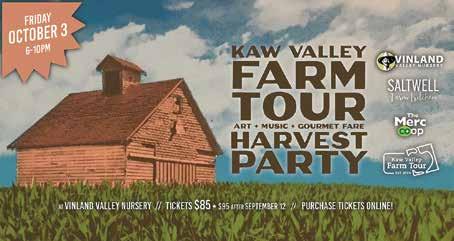
ent a tasting menu of small plates, entrees, and dessert stations available throughout the nursery with seasonal dishes created by twice James Beard Nominee, Chef Rozz Petrozz, co-owner of Saltwell Farm Kitchen. Food stations will feature a variety of seasonal dishes with tastes inspired by plants in the nursery.
Hotlines for Gardeners
Extension Master Gardeners are ready to answer all your gardening questions.
CASS COUNTY
816-380-8194; Wed, 9am-noon; casscomg@gmail.com
DOUGLAS COUNTY
785-843-7058; dgcogardenhotline@gmail.com; Mon, Wed, Fri, 1-4pm
GREATER KANSAS CITY MISSOURI AREA
816-833-8733 (TREE); Mon-Fri, 9am-noon; mggkc.hotline@gmail.com
JOHNSON COUNTY, KS
913-715-7050; Mon-Fri, 9am-4pm; garden.help@jocogov.org
JOHNSON COUNTY, MO
660-747-3193; Wed, 9am-noon
LEAVENWORTH COUNTY
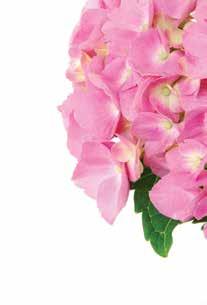
913-364-5700; Leave a message. A Master Gardener will contact you.
MIAMI COUNTY & LINN COUNTY
913-294-4306; Thurs, 8am-noon
WYANDOTTE COUNTY
913-299-9300; Mon-Fri, 9am-4pm
QUESTIONS ABOUT ROSES?
Ask a Rosarian; rosehelp@kcrosesociety.org; www.kansascityrosesociety.org
Two signature Saltwell cocktail pairings will be included in the progressive dining event, and a cash bar will be open throughout the evening. A variety of culinary experiences will be provided that honor dietary restrictions and non-alcoholic options.
The Harvest Party will feature video projections by Lawrence art-
ists Marlo Angell and Peter Jasso, as well as live music by the Jubilee Mystics. Ticket purchasers are automatically entered to win an original print by Justin Marable, featured artist for the 2025 Lawrence Art in the Park.
Harvest Party proceeds will benefit the Lumberyard Arts Center, a cultural heritage site on the farm tour. Located in Baldwin City, the arts center is a creative community hub for public art, live local music, theatre, and rotating art exhibits.
Tickets to the Harvest Party can be purchased online at vinlandvalleynursery.com and in person at Vinland Valley Nursery. Kaw Valley Farm Tour tickets are available online at kawvalleyfarmtour.org, and in person at the K-State Extension Office, Cottin’s Hardware & Rental, The Merc, and Vinland Valley Nursery.
SUBSCRIBE TODAY
For convenient mail delivery, complete the form below and send with your check for $38.00. You will receive a one-year subscription.



Late-Blooming Perennials
Bring a flash of color to your landscape every fall by planting purple or pink asters, yellow solidago, helenium, heliopsis, and more! Learn more about perennials with fall blooms at Suburbanlg.com/fall-perennials
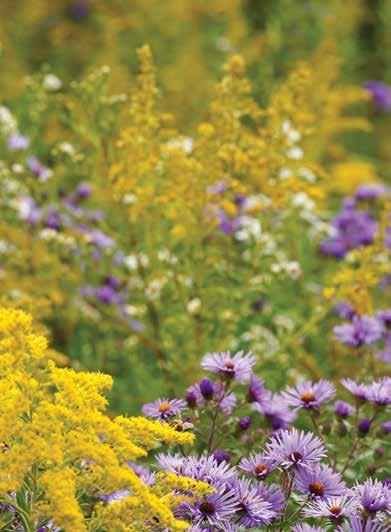
1 gal pots start at $8.99
Fall Flowers & Produce

Refresh flower beds and pots with something from our huge selection of cool-weather annuals. Specialty pumpkins and gourds arrive mid-September, which make a great accent.
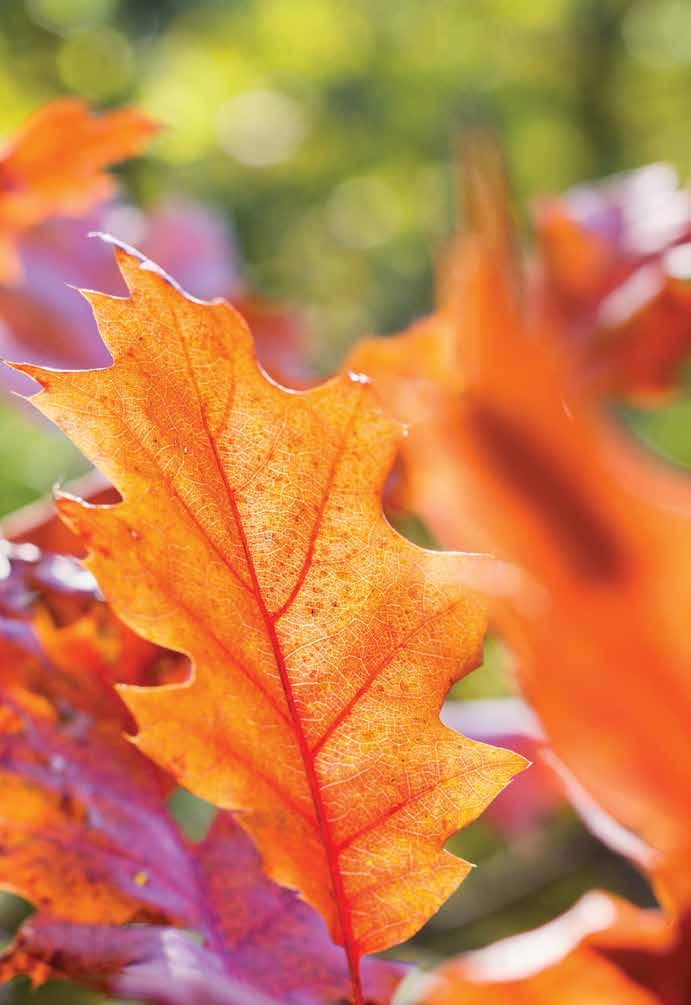
Take 20-50% off select maples, crab apples, oaks and more during our annual Autumn Tree Sale. Shop early for the best selection. Learn more at SuburbanLG.com/Fall-Nursery-Sale
